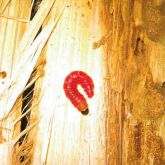Culama wood moth

Culama larva
© Queensland Government

Adult Culama moth
© Queensland Government

Culama larva under bark
© Queensland Government

Exposed sapwood, kino and fungal staining, due to extensive feeding on cambium by Culama larvae
© NSW DPI
Culama wood moths are medium-sized. Their pink or red larvae feed under bark, which eventually falls away. Infestations are often visible as large areas of exposed sapwood, with accompanying webbing, coarse frass, and sometimes the presence of larvae. The moths are rarely seen.
Scientific name
Similar species
- There are around 7 species in the Culama genus, and they are all similar to one another.
- Culama species are also similar to moths from the closely related Zyganisus and Macrocyttara genera.
Description
- Adults are medium-sized moths with a 30–60mm wingspan.
- They are motley brown-grey and are rarely seen.
- Their forewings have a rounded apex and are grey with a pattern of grey and thin black stripes. Their hindwings are paler and grey.
- Their wings are wrapped around the body when at rest.
- Their antennae usually have a comb-like appearance.
- The larvae are pink to red and grow up to 40mm long.
- Larvae feed in clusters under the bark, which eventually falls away from the site of attack, exposing the sapwood.
Distribution
- Culama australis and C. glauca moths are found throughout Queensland.
Hosts
Hosts include a wide range of eucalypt species, such as:
- spotted gum (Corymbia maculata)
- Dunn's white gum (Eucalyptus dunnii)
- rose gum (E. grandis) and hybrids
- bimble box (E. populnea).
Damage
- Damage by Culama species usually follows an attack by longicorn beetles (Phoracantha species) or the giant wood moth (Endoxyla cinereus). It can also occur when bark splits during drought. Both these situations allow the moths to access the cambium layer.
- Larvae feed around the cambium and sapwood, with tunnels sometimes extending far into the sapwood. This reduces the tree's ability to transport water and nutrients, and weakens affected stems and branches.
- Sites of attack are often reinfested, and a range of larval stages may be present. The bark eventually falls away from the infested site, exposing the sapwood to fungal staining, rot and further damage.
- Severe attacks can ringbark and kill young trees.
Biology
- Small (less than 1mm) broadly elliptical eggs are laid in crevices in bark, usually singly or in small groups.
- The red larvae cluster in galleries beneath the bark. The larvae pupate in an oval cocoon either in the larval galleries or in the soil.
- The main flight period of moths is from late spring to early autumn.
- Before mating, females are generally inactive. Their pheromones can attract males from a considerable distance.
- Adult males fly rapidly in search of unfertilised females and come readily to lights at night.
Control
- Natural predators include birds, assassin bugs, beetles and parasitoid wasps.
- A sex pheromone formulation for C. australis has been developed. This could help with monitoring and trapping, but more research is needed before it can be used.
- If an infestation is noticed early, and if it is feasible, insert a mild contact insecticide in holes made with pliable wire.
- Remove and burn severely affected limbs , then paint all cuts with a wound-sealing compound.
- Remove dying or dead trees to prevent infection of healthy individuals.
Resources and research
- Carnegie, AJ, Lawson, SA, Smith, TE, Pegg, GS, Stone, C, McDonald, JM, 2008, Healthy hardwoods: a field guide to pests, diseases and nutritional disorders in subtropical hardwoods. Forest & Wood Products Australia, Victoria.
- Common, IFB, 1990, Moths of Australia. Melbourne University Press, Carlton, Victoria.
- Jones, DL, Elliot, WR, Jones, SR, 2015, Pests, diseases, ailments and allies of Australian plants, Reed New Holland Publishers Pty Ltd, Chatswood, NSW.
- Kallies, A, Hilton, DJ, 2012, Revision of Cossinae and small Zeuzerinae from Australia (Lepidoptera: Cossidae), Zootaxa, 3454:1–62.